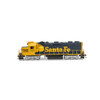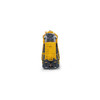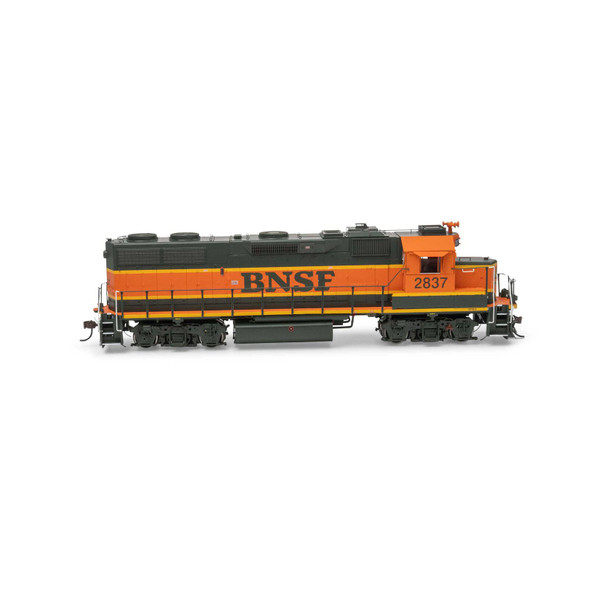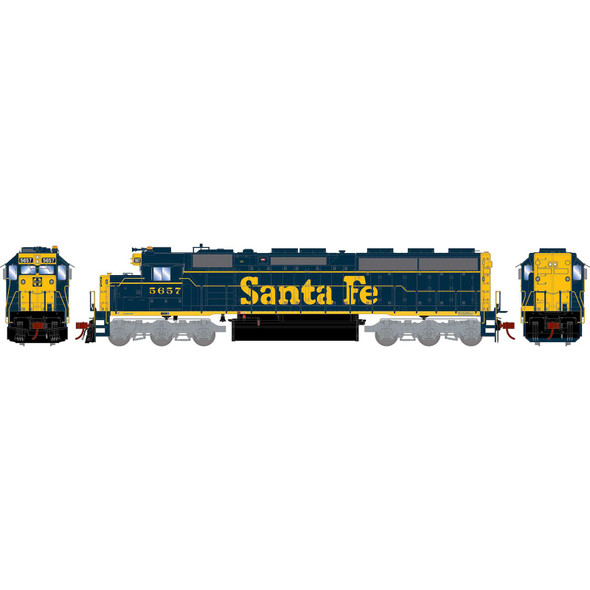Athearn
Athearn ATHG66253 GP39-2u Locomotive, ATSF Santa Fe #3415 HO Scale
- SKU:
- ATHG66253
- UPC:
- 797534662537
- Condition:
- New
Description
ATSF FEATURES:
New Santa Fe phase 1 GP39-2u body with corrugated grilles — First time in Genesis!
Illuminated “Swing out” style number boards
Stratolight Beacon (effect in DCC)
Newly tooled exhaust stack
Removed class lights
“Switcher” style walkway steps
Rear mounted fuel tank
Large front anticlimber
Starting in 1986, Santa Fe rebuilt 50 GP39-2’s in their Cleburne, TX shops, designating them as “GP39-2u’s”. The “u” stood for “upgrade” which was a common term for Santa Fe rebuilds during this time. Other than the mechanical and electrical upgrades, Santa Fe added some unique details that distinguish these from their non-rebuild counterparts. These changes include: Fuel tank moved to the rear, new “swing out” style number boards, new style exhaust stack, and added an equipment door to the right side hood, just behind the cab. They also featured “switcher” style walkway steps for crew comfort during switching moves. A few even received modified corrugated radiator grilles.
ROAD NUMBER SPECIFIC FEATURES:
#3409
PH 1 body with chickenwire grilles
Leslie 3-chime horn
added access equipment door behind cab
#3415
PH 1 body with chickenwire grilles
Leslie 3-chime horn
added access equipment door behind cab
#3418
New PH 1 body with corrugated grilles
Nathan 3-chime horn
added access equipment door behind cab
GP39-2 LOCOMOTIVE FEATURES:
Coupler cut levers
Trainline and MU hoses
Drop steps unless noted
MU stands
Windshield wipers
Lift rings
Wire grab irons
Walkway tread
Sanding lines
Lit number boards
Lit class lights, if equipped
Lit signal lights and/or beacons, if equipped
Bell placement & type per prototype
Detailed fuel tank with fuel fillers, fuel gauges, and breather pipes
Blomberg-B or Blomberg-M trucks with appropriate bearing caps
Speed recorder unless noted
See-through cab windows and full cab interior
Fine-scale Celcon handrails for scale appearance
Etched metal fan grilles
Air tanks mounted below sill unless noted
Body-mounted McHenry® scale knuckle couplers - Kadee® compatible
DCC-ready features Quick Plug™ plug-and-play technology with 21-pin NEM connector
Scaled from prototype resources including drawings, field measurements, photographs, and more
Accurately painted and printed paint schemes
Genesis driveline with 5-pole skew wound motor, precision machined flywheels, and multi-link drivetrain
All-wheel drive with precision gears for smooth & quiet operation
All-wheel electrical pickup provides reliable current flow
Wheels with RP25 contours operate on all popular brands of track
LED Lighting for realistic appearance
Heavy die-cast frame for greater traction and more pulling power
Packaging securely holds for the model for safe storage
Minimum radius: 18”
PRIMED FOR GRIME MODELS FEATURE
Duplicated look and feel of “In Service” equipment
Faded base colors matched to the prototype
Perfect starting point for adding grime and rust
SOUND-EQUIPPED MODELS ALSO FEATURE
Onboard DCC decoder with SoundTraxx Tsunami2 sound
Dual cube speakers for optimal sound quality
Sound units operate in both DC and DCC
Full DCC functions available when operated in DCC mode
Engine, horn, and bell sounds work in DC
All functions NMRA compatible in DCC mode
Precision slow speed control
Program a multiple unit (MU) lashup with lead unit only horn, bell, and lights
Many functions can be altered via Configuration Value (CV) changes
CV chart included in the box
PROTOTYPE SPECIFIC INFORMATION
In the decade between 1974 and 1984, EMD produced the GP39-2 for seven North American railroads. The basic design followed most four axle road diesel switchers for the time. Borrowing improvements from the GP38-2 and GP40-2 designs, this mid-horsepower road switcher utilized a turbocharged 12-cylinder EMD 645E3 diesel engine for its prime mover. With 4 fewer cylinders, the smaller engine provided a distinctive long hood on the phase II and phase III bodies, where the clean room/engine compartment doors were set back from the cab further than predecessor locomotives.
Sensitivity to fuel economy in the 1970s justified the GP39-2 in the locomotive market. It also laid the ground work for EMD to start exploring locomotive designs that utilize engines with larger piston displacement yet possess fewer cylinders. This approach has become the foundation to modern locomotive technology.




















